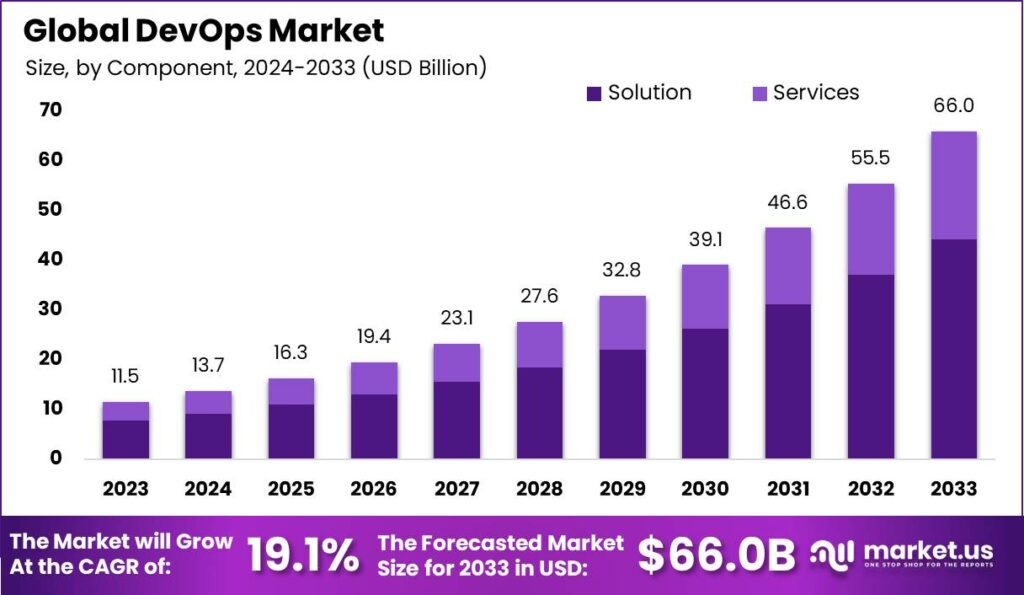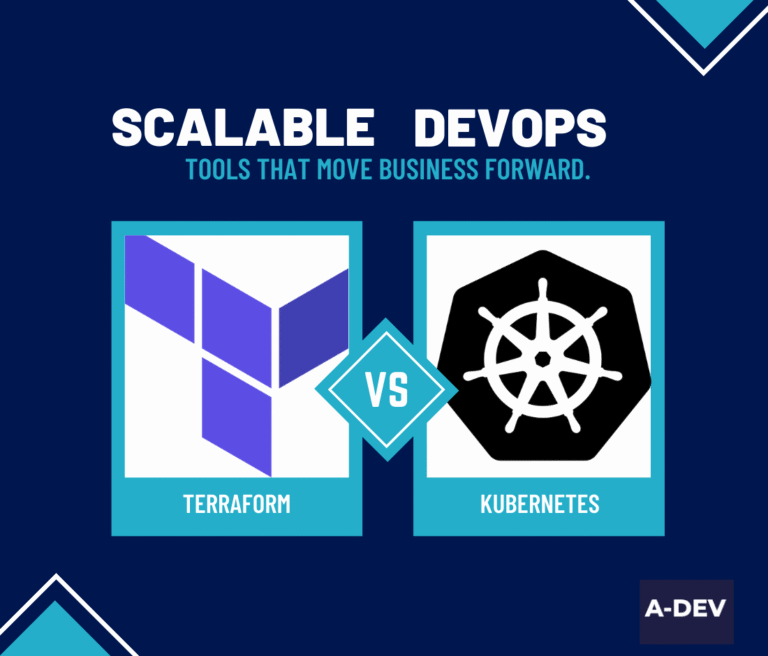I. Introduction

Did you know that companies leveraging DevOps deploy software 20 times faster and encounter 30% fewer failures? These compelling statistics underscore the transformative impact of DevOps in today’s digital landscape. Embracing DevOps isn’t just about adopting a new methodology; it signifies a paradigm shift in how businesses operate. It’s about swiftly delivering updates, securely and precisely meeting customer demands, and surpassing traditional development models. DevOps serves as the linchpin that seamlessly connects development and operations teams. Through interaction, automation, and continuous improvement, it heralds a new era of software development, where agility, efficiency, and innovation reign supreme, propelling businesses ahead in the dynamic DevOps market.
But transitioning to DevOps can feel daunting. Questions swirl – is it the right fit, how do we navigate the changes, where do we even start? This blog post is your roadmap to unlocking the DevOps advantage. We’ll delve into the thriving DevOps market, dispel any myths about its decline, and showcase its impressive growth potential. You’ll explore key trends and future-proof technologies shaping the landscape, like AI and automation, and most importantly, we’ll answer your crucial questions:
- Is DevOps right for your business?
- What are the key drivers of its success?
- How can you leverage DevOps to gain a competitive edge?
- And most importantly, how do you get started?
Rest assured, we’re here to guide you on this journey. Packed with insights, data, and real-world examples, this blog post equips you with the knowledge and confidence to unlock the power of DevOps and unlock a new era of innovation and success for your business. So, buckle up, get ready to learn, and let’s chart a course towards unprecedented agility and value together.
II. Deep Dive into the DevOps Landscape
1. Debunking the Myth: Is the Global DevOps Market Really Down?
The notion of a declining DevOps market persists in some circles. However, examining data reveals a different story: DevOps is thriving and poised for significant market growth.

- Global DevOps Market size and projections: In the competitive landscape of the global DevOps market, projections indicate significant market growth momentum. According to Market.us, the market size is poised to soar to approximately USD 66.0 Billion by 2033, a remarkable surge from USD 11.5 Billion in 2023. This trajectory is underpinned by a forecasted Compound Annual Growth Rate (CAGR) of 19.1% from 2024 to 2033. As businesses vie for prominence in this dynamic arena, harnessing DevOps practices becomes imperative for staying competitive and driving innovation.
- Regional expansion: the growth of the global DevOps industry is not limited to specific regions. North America, Europe, and Asia Pacific are all experiencing substantial market expansion, highlighting the widespread adoption and global appeal of DevOps practices. This regional diversification further solidifies DevOps as a transformative force in shaping the future of programming development and IT operations on a global scale.
Adaptability in the Face of Challenges:
Challenges like talent shortages and integration complexities are real concerns. However, the DevOps market is known for its adaptability:
- Innovative solutions: New solutions and approaches are constantly emerging within the DevOps market to address skill gaps and integration hurdles.
- Talent development initiatives: Talent development initiatives within the DevOps market include training programs and certifications that are helping bridge the talent gap and ensure a skilled workforce.
The Global DevOps Market is witnessing robust expansion, primarily driven by the escalating demand for accelerated software delivery and improved operational efficiency across various industries. This growth trajectory underscores the significance of DevOps in modern software development, as it bridges the gap between development and operations teams, leading to enhanced speed and quality throughout the software development lifecycle.
2. Charting the Course: Navigating the Global DevOps Landscape (2023-2030)
Embarking on this journey through the DevOps market, let’s leverage the provided industry report to gain critical insights into key trends, projected market growth, and potential challenges.
Anticipated Growth Trajectory:
- Global DevOps Market: The DevOps market analysis report predicts the global DevOps market share to reach a colossal USD 274.56 billion by 2028, fueled by an impressive CAGR of 19.7%. This signifies a sustained upward trend within the market, highlighting its immense potential.
- Regional Variations: Growth isn’t uniform across regions. While North America leads the charge, Europe and Asia Pacific are experiencing significant expansion, showcasing the global adoption of DevOps practices. Specific data highlighting regional differences will be crucial to understanding the nuances of DevOps market share.
Emerging Trends Shaping the Future:

- Cloud-Native Solutions: Several reports focusing on the growth of the DevOps highlight the rising popularity of cloud-native solutions, valued for their agility, scalability, and flexibility. We will explore how these solutions are transforming infrastructure management and deployment approaches.
- Security Automation: In a landscape with evolving threats, global market reports emphasize the growing importance of security automation, particularly for large enterprises. We will delve deeper into the potential of automated tools for continuous security throughout the development lifecycle.
- AI Integration: Some reports provide insights into AI integration within DevOps, covering areas like intelligent testing, predictive analytics, and automated pipeline optimization. We will showcase how AI is poised to revolutionize how we build and manage software.
Potential Challenges to Navigate:
- Talent Shortages: There is a critical issue of talent shortage within the DevOps market. We will analyze its findings on the severity of the gap and explore potential solutions, such as training programs and talent acquisition strategies.
- Integration Complexities: Integrating diverse toolsets and legacy systems can be challenging. We will discuss the report’s perspective on these complexities and offer strategies for successful integration.
- Security Concerns: Robust security practices are crucial throughout the DevOps pipeline. We will analyze the report’s recommendations for ensuring application security amidst evolving threats.
By understanding these key trends and challenges, we can navigate the exciting and dynamic world of DevOps, capitalizing on its potential while proactively addressing its hurdles. Stay tuned as we delve deeper into each of these areas, equipping you with the knowledge and insights to succeed in this rapidly evolving landscape.
3. Future-Proofing Your Business: DevOps Solutions for Software Development
Now that we’ve explored the thriving DevOps market research report and its exciting future trajectory, let’s delve deeper into the solutions that empower businesses to harness this transformative potential. In this section, we’ll unveil how AI and automation are reshaping software development and driving DevOps forward.

AI and ML: Revolutionizing the Development Landscape:
- Predictive Analytics: Imagine optimizing resource allocation and anticipating bottlenecks before they occur throughout the entire software development lifecycle. AI-powered analytics unlock this power, allowing you to make informed decisions and ensure efficient development processes.
- Automated Testing and Quality Assurance: Eliminate tedious manual testing and embrace the speed and accuracy of automated solutions. Artificial intelligence and machine learning fuel tools that rigorously test code, identifying and addressing potential issues early in the development cycle, ultimately enhancing code quality and security.
- Continuous Improvement: DevOps thrives on continuous learning and optimization. AI-powered tools enable your pipelines to self-learn and adapt, constantly improving efficiency and performance through data-driven insights.
Building a Secure and Agile Future:
Automation and AI/ML aren’t just about efficiency; they’re key drivers of security and agility in the DevOps world, empowered by cutting-edge DevOps tools.
- Enhanced Security: Proactive threat detection and vulnerability management become a reality with AI and automation. These tools continuously scan for vulnerabilities, identify potential threats, and take corrective actions, safeguarding your applications and data.
- Increased Agility: Faster deployment cycles and improved responsiveness are hallmarks of a successful DevOps strategy. Automation empowers you to streamline processes, automate deployments, and react quickly to changes, giving you a competitive edge in the fast-paced digital landscape.
4. Driving the Momentum: Key Factors Behind DevOps Market Growth

The global DevOps market isn’t just thriving; it’s experiencing an explosive surge, driven by several key factors that are converging to create a perfect storm of opportunity. Let’s explore these factors and understand the underlying forces shaping the market’s trajectory:
Cloud Adoption: The Catalyst for Change:
Cloud computing has become the de facto standard for modern software development, and it’s acting as a powerful catalyst for DevOps adoption. Here’s how:
- Scalability and Elasticity: Cloud infrastructure offers on-demand scalability and elasticity, enabling rapid development and deployment cycles. DevOps practices are perfectly suited to leverage this flexibility, allowing organizations to scale resources up or down based on changing needs.
- Cost Optimization: Cloud models like pay-as-you-go eliminate the need for upfront hardware investments. Combined with DevOps practices that automate resource management, organizations can optimize costs and eliminate resource wastage.
- Improved Collaboration: Cloud environments bridge the physical divide between development and operations teams, facilitating seamless cooperation and communication. This aligns perfectly with the core DevOps philosophy of breaking down silos and fostering a shared ownership culture.
Agile: A Perfect Match for DevOps:
Agile software development methodologies and DevOps principles are two sides of the same coin, both promoting iterative development, continuous improvement, and rapid feedback loops. This natural synergy is accelerating the adoption of both:
- Iterative Development: Agile practices break down development into smaller, manageable sprints, allowing for continuous feedback and rapid adaptation. This aligns perfectly with DevOps’ emphasis on continuous integration and delivery, enabling teams to respond quickly to changing requirements and market trends.
- Empowered Teams: Agile empowers development teams with ownership and accountability throughout the entire lifecycle. This aligns seamlessly with DevOps principles that break down silos and promote cross-functional interaction, leading to a more engaged and productive workforce.
Security First: A Non-Negotiable Imperative:

In today’s threat landscape, security can’t be an afterthought. The DevOps market is increasingly driven by the need for “security-first” strategies:
- Integrating Security Tools: DevOps solutions now seamlessly integrate security tools for automated testing, vulnerability scanning, and code analysis throughout the development pipeline. This proactive approach significantly reduces security risks and ensures code integrity.
- Compliance and Governance: As regulations and compliance requirements become more stringent, organizations are seeking DevOps solutions that adhere to industry standards and facilitate governance processes. This ensures adherence to regulations and safeguards sensitive data, building trust with customers and stakeholders.
These are just some of the key factors propelling the DevOps market forward. By understanding these forces and aligning your organization with the principles of DevOps, you can unlock its transformative potential and achieve a competitive edge in the ever-evolving software landscape.
III. Market Landscape and Your Competitive Advantages
1. Unveiling the Scale: The Thriving DevOps Market in 2024
The DevOps market is booming, painting a picture of immense potential for the enterprises and businesses embracing these practices. In 2024, the global market size is expected to reach a staggering USD 10.4 billion, with a remarkable CAGR of 19.7% projected until 2028. This translates to a market size of USD 274.56 billion by then, highlighting the explosive growth trajectory.
However, the DevOps market growth isn’t uniform. North America currently leads the pack, but regions like Europe and Asia Pacific region are experiencing significant expansion of the DevOps market, showcasing the global appeal of DevOps. This diverse landscape presents exciting opportunities for organizations worldwide.
Furthermore, the impact of DevOps extends beyond its own market size. It’s fueling the entire DevOps market, contributing significantly to faster innovation, improved efficiency, and enhanced customer satisfaction. By embracing DevOps, you’re not just investing in specific market segments; you’re unlocking a competitive edge in the broader software development landscape.
2. Dominating the Deployment Landscape: CI/CD Takes the Lead

Among various segments within the DevOps market, Continuous Integration/Continuous Delivery (CI/CD) solution stands as the current champion, holding the largest market share based on deployment tools and methodologies. This dominance is driven by several factors:
- Faster releases: CI/CD empowers rapid code release cycles, enabling businesses to respond swiftly to market changes and deliver value to customers more frequently.
- Improved quality: Automated testing and integration within CI/CD pipelines ensure continuous code quality, reducing defects and minimizing production issues.
- Enhanced collaboration: By seamlessly connecting Application Development and IT Infrastructure teams, CI/CD fosters better communication and cooperation, leading to greater efficiency and alignment.
Emerging trends within the DevOps market further amplify its appeal. The rise of cloud-based CI/CD strategy and automation tools further streamlines development workflows and offers greater scalability. By focusing on CI/CD strategy, you’re aligning yourself with a dominant and rapidly evolving segment.
More Than Just Tools: A-Dev, Your Partner for Comprehensive CI/CD Success
As DevOps continues to revolutionize software development, the CI/CD segment remains at its core. A-Dev understands this and aligns its offerings perfectly with the needs of companies looking to streamline their releases, accelerate delivery, and optimize their development workflows.
Here’s how A-Dev empowers you to leverage the full potential of CI/CD using industry-leading resources and platforms:
- Faster deployment: Leveraging resources like Amazon Web Services (AWS) and Microsoft Corporation, our expertise in automating testing, provisioning, and configuration management translates to 50% faster deployment times, enabling you to get features and updates to your users quicker.
- Increased release frequency: With AWS tools like AWS CodePipeline and AWS CodeDeploy, along with other industry-standard platforms, we help you triple your release frequency, staying ahead of the competition and meeting ever-evolving market demands.
- Minimal manual intervention: Our methodology reduces manual intervention by 80%, freeing up your development team to focus on high-value activities like innovation and problem-solving. Through automation tools like AWS CodeBuild, we streamline your workflows, minimizing human error and maximizing efficiency.
- Tailored solutions: We don’t believe in one-size-fits-all approaches. Leveraging leading CI/CD tools like GitLab CI/CD, Jenkins, Microsoft Corporation and CircleCI, among others, we design and implement practices customized to your unique needs and development environment.
- Beyond tools and expertise: A-Dev offers more than just technology. We provide ongoing support, training, and guidance to ensure your team successfully adopts and adapts CI/CD practices for long-term success.
Ready to join the CI/CD revolution? Contact A-Dev today for a free consultation and discover how we can help you unlock the full potential of CI/CD, leveraging top-notch resources and platforms, to achieve your software development and manufacturing goals.
3. Beyond Tools and Methods: A Thriving Ecosystem of DevOps Solutions
While CI/CD plays a crucial role in streamlining software delivery, the DevOps industry encompasses a wider range of strategies that empower organizations to fully embrace DevOps principles. Let’s explore some key segments beyond CI/CD:
DevOps Solutions:
- Automation Tools: These tools automate repetitive tasks like infrastructure provisioning, configuration management, and testing, freeing up development teams to focus on strategic initiatives.
- Collaboration Platforms: These platforms facilitate seamless communication and cooperation between Application Development and IT Infrastructure teams, breaking down silos and fostering a shared ownership culture.
- Monitoring & Analytics Tools: These tools provide real-time insights into application performance, infrastructure health, and security posture, enabling proactive issue identification and resolution.
DevOps Services:
- Consulting Services: Experienced consultants guide organizations through their DevOps journey, providing strategic planning, implementation roadmaps, and best practice recommendations.
- Training & Education: Training programs equip teams with the skills and knowledge needed to adopt and effectively utilize DevOps tools and practices.
- Managed Services: Managed service providers handle specific DevOps tasks or manage the entire DevOps environment, allowing organizations to focus on their core business objectives.
Interconnected Ecosystem:
These segments work interdependently to create a holistic DevOps environment. CI/CD pipelines leverage automation tools for efficient delivery, while interactiven platforms foster communication across teams using insights from monitoring & analytics tools. DevOps services provide expertise and guidance to ensure successful adoption, deployment model and optimization of these strategies.
A-Dev’s Expertise:
A-Dev recognizes the power of this interconnected ecosystem and offers comprehensive strategies across various segments:
- CI/CD Solutions: We provide industry-leading CI/CD tools, pre-built pipelines, and custom integrations to accelerate your delivery cycles.
- DevOps Automation: Our automation tools streamline infrastructure management, configuration, and testing, minimizing manual intervention.
- DevOps Collaboration Platform: Our platform facilitates real-time communication, visibility, and knowledge sharing across Development & IT teams.
- DevOps Consulting Services: Our experienced consultants help you define your DevOps strategy, roadmap, and implementation plan, ensuring a smooth and successful transformation.
- DevOps Training & Education: We offer comprehensive training programs to equip your team with the necessary skills and knowledge to thrive in a DevOps environment.
By partnering with A-Dev, you gain access to a full spectrum of strategies and expertise across the DevOps ecosystem, enabling you to optimize your software development process, achieve faster releases, and gain a competitive edge.
Conclusion: Embrace the DevOps Revolution and Thrive
The journey through the DevOps landscape has unveiled a vibrant and dynamic market brimming with potential. We’ve explored the sector’ impressive growth trajectory, the dominance of CI/CD, and the diverse ecosystem of strategies that empower organizations to embrace DevOps practices.
Key Takeaways:
- The global DevOps market is experiencing explosive market growth, fueled by the need for faster software delivery, improved quality, and enhanced cooperation.
- CI/CD stands as the leading segment, offering organizations the ability to release features and updates more frequently and efficiently.
- Beyond CI/CD, a rich variety of DevOps tools exists, encompassing automation tools, collaboration platforms, monitoring & analytics tools, and various services.
- Partnering with a proven expert like A-Dev provides access to comprehensive toolkits, expertise, and guidance, ensuring a smooth and successful DevOps transformation.
The Future is DevOps:
DevOps is not just a trend; it’s a transformative movement fundamentally reshaping how software is built and delivered. By embracing its principles, organizations can unleash a wave of innovation, gain a competitive edge, and delight their customers with faster, more reliable, and higher-quality software.
Remember, the DevOps journey is continuous. As technology evolves and new challenges emerge, so too will the global DevOps market and its strategies. However, the core principles of collaboration, automation, and continuous improvement remain constant. By staying informed, adapting your approach, and partnering with trusted experts, you can navigate the ever-changing competitive landscape and unlock the full potential of DevOps to achieve lasting success in the years to come.
Ready to embark on your DevOps journey? Contact A-Dev today and let’s explore how we can help you turn DevOps into a powerful driver of your business success.






